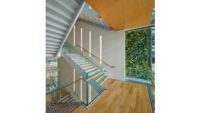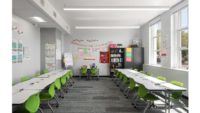|
Spaulding Rehabilitation Hospital
Location: Charlestown, Mass. Building Type: Replacement Rehabilitation Hospital Size: Total New Building: 378,367 gross square feet; Parking levels: 117,029 gross square feet; Floors 1-8: 236,585 gross square feet; Mechanical Penthouse: 24,754 gross square feet Completion Date: 2013 Certification: LEED Gold |
Residents and businesses in the U.S. have learned firsthand the devastating effects of severe weather. Wise owners and their building teams are taking these tragedies and using the lessons learned to help minimize the damage caused by future events. Spaulding Rehabilitation Hospital and Partners HealthCare implemented many of these lessons in its replacement hospital in Charlestown, Mass., and even went one step further by ensuring that its lower levels would stay above the water line for 100 years as climate change allows levels to encroach on coastlines worldwide. The ground floor was raised 30 inches above the 100-year floodplain elevation. The landscape has a 3-foot berm around the perimeter. And perhaps most challenging of all, the entire mechanical and electrical infrastructure was located on the roof just to be safe. The building’s design incorporates a great number of foresighted resilience ideas.
But that’s a story for the future.
In the here and the now, patients at Spaulding Rehabilitation Hospital are concerned with getting top-notch care—the kind of care that Partners HealthCare fosters in its network.
Recent examples of the organization’s excellent care have emphasized sustainability. These examples include the LEED Silver Carl J. and Ruth Shapiro Cardiovascular Center at Brigham and the Women’s Hospital in Boston which pioneered some energy conservation ideas. Another Boston project is the LEED Gold Lunder Building at Massachusetts General Hospital.
“The Lunder Building is a complete triumph,” says Robin Guenther, FAIA, LEED AP BD+C, principal and global sustainable healthcare leader for Perkins+Will. “The architectural firm for Lunder, NBBJ, produced inspired medical planning. It demonstrates that you can fundamentally transform the experience in a healthcare building on a tight urban site. For the Spaulding project team, it set a high design bar.” With each successive project, Partners’ goal is to be more sustainable, which meant that Spaulding needed to exceed the level of sustainable design achieved at the Lunder Building.
Project Team
|
Guenther believes that a reason healthcare hasn’t wholeheartedly embraced green and rating systems such as LEED stems from the notion that the core mission to save lives cannot be compromised for environmental considerations—and the fear that sustainability is about “less.” But thanks to the projects that came before Spaulding, Partners HealthCare has demonstrated that sustainability supports and improves the core mission. This knowledge was an influential factor with many of the client’s decisions. One such decision was the site.
Site Therapy
Inclusive design was incorporated into every aspect of the facility because of the program goal to connect rehabilitation patients to other people and to nature. Much of the team’s ability to make those connections stemmed from the project site, a brownfield waterfront parcel in the Charlestown Navy Yard that came with significant development qualifications.
For example, the public needed to have open access to the waterfront boardwalk across the site, and the Boston Redevelopment Authority required a minimum of 75 percent of the ground floor for public uses. “What’s brilliant about Spaulding is that it’s the perfect healthcare use for that set of covenants,” says Guenther. “A rehab hospital is about reverse inclusion. It’s about taking people who have been severely injured and giving them their lives back.”
Guenther goes on to describe that the connectivity between residents and the public helps people getting back to their former level of physical ability or learning to adjust to a “new normal” adapt to life outside the hospital’s walls without leaving the hospital’s care. To that end, the public has access to areas such as a restaurant/cafeteria, community rooms, public toilets and visits to a pool system used by patients for therapy during the day. “It turned out to be an incredible match of program and place,” she adds.
Visual connectivity is also greatly important. An open and inviting atmosphere was created by incorporating a glass curtain wall to allow an abundance of natural light throughout the interior. Triple glazing was used for energy efficiency, and the owner opted for key-operable windows in patient rooms. Operable windows are not typically used in healthcare because they may bring in outdoor air that can, debatably, negatively affect patients. Another factor is, of course, open windows adversely affecting energy efficiency.
Learning another lesson from the recent past, though, Partners opted for operable windows to ventilate the facility in case a weather event or other emergency forces building systems to shut down. This option allows people to be potentially sheltered in the building for longer periods of time. “It’s not a strategy to be used everywhere,” Guenther says, “but using operable windows in a healthcare facility can prevent the building from overheating should all ventilation systems fail.”
Operable windows were actively used in the gymnasium for another reason: sound. Natural ventilation was again requested, and the mechanical engineer suggested using the mechanical ventilation system to achieve the desired result. It was pointed out during this discussion that doing so would reduce patient contact with nature—the sounds of birds, people, boats on the harbor and so on. Guenther describes the event as “a cathartic moment where everyone understood that window operability was about more than air.”
Pebbles of Inspiration
Even though patients of Spaulding will have had interaction with people and nature during their stay at the rehabilitation hospital, there are bound to be a few questions that can’t be answered until they begin experiencing life post-rehab—away from immediate medical care. The same goes for the project team. Now that the facility is in operation, how will the strategies incorporated pay off? How will Partners HealthCare leap over the new sustainable heights created with Spaulding? What do hospitals like this mean for the environment?
“The most successful sustainable strategies are the ones that connect to clients’ mission, vision and value,” says Guenther. “Those are the strategies that survive value engineering, and they survive critics because they acquire a life of their own.”
In the case of Spaulding, connections to the mission, vision and value for Partners HealthCare are seen in strategies such as the operable windows in a gym, a commitment to brownfield remediation, resilience measures and more. These are the strategies that will hopefully help change people’s lives for the better while at the same time helping inspire people to operate and think differently. They will let people see that change is possible.
“I see how Spaulding has changed the lives of the Partners and Perkins+Will team members,” says Guenther. “I think that’s why I help put these buildings in the world: sustainable buildings are transformation agents. But saving the planet is a big job, and buildings like these are little pebbles that hopefully demonstrate a way of coexisting with nature with fewer negative consequences. I think there’s great work going on right now, and it’s speeding up.”
|
Up to the Challenge Although she was on the periphery of the many talented and experienced members of the project team, Guenther brought with her a skill set uniquely suited to helping the team top what came before. She was schooled in the energy crisis of the late 1970s. As such, her education focused on sustainability and not healthcare. As the crisis waned and people returned to a “business as usual” approach in the 80s there wasn’t much demand for someone schooled in green. So Guenther made the shift to healthcare where her affinity for natural materials blended nicely with healthcare’s nascent shift toward biophilic design in the 90s. It was an opportunity that wasn’t wasted by Guenther who received the Center for Health Design’s Changemaker Award for her leadership and innovation in the design of healing environments in 2005, went on to be named the “#1 Most Influential Designer in Healthcare” by Healthcare Design magazine in 2010, and was named one of the “100 most creative people in business” by Fast Company in 2012. She also co-coordinated the Green Guide for Health Care, served on the LEED for Healthcare committee, and released the second edition of “Sustainable Healthcare Architecture,” which she co-wrote with Class of 2012 LEED Fellow Gail Vittori in May 2013. |
|
Materials and Sources
Exterior Material Palette @ Building Podium Glazing System:
Glass Type:
Sunshades:
Brick Type:
Precast Sills:
Exterior Metal Panels: Flat:
Standing Seam:
Glazing System:
Glass Type:
|
Project Features Site History, Remediation and Restoration
Community Connectivity
Inclusive Design
|













Report Abusive Comment